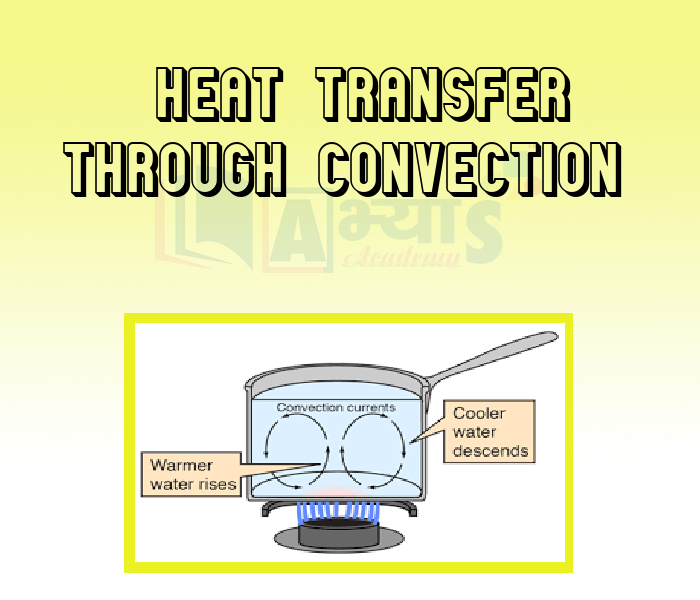Heat Transfer Through Convection


Heat Transfer Through Convection
Convection
The transfer of heat because of movement of the molecules of the medium; via mass transfer; is called convection or convection of heat.Water and air are bad conductors of heat. But they do become hot, in spite of being bad conductors. Heat transfer in fluids takes place through convection.
Convection in Water:
When water is heated in a pan, the particles of water which are near the source of heat; get heated first. Because of heating, they become light; and rise in water. The gap which is created because of rise of hot particles is filled cold particles of water from the surrounding area. Thus a cyclical movement of particles begins and ends up heating the whole water of the pan. The cyclical movement in fluids because of heating is called convection current.
Convection in Air:
Air gets heated because of convection; the way water gets heated. Air near the source of heat gets heated and rises above. This leaves a gap; which is filled by the colder air from the surrounding. The convection current thus starts in air which results in heating up of air.
When you place your palm above a flame you will feel the hotness of the flame. But when you will place your palm below the flame the area will be colder. This shows how the colder air from below moves up; due to convection current.
Land and Sea Breeze:
Sea Breeze: In coastal areas, the breeze that moves from sea surface to the land is called sea breeze. This happens because, during daytime, land gets heated more quickly than water. As a result, warm air from land rises up; leaving a gap. To fill that gap, colder air from the ocean surface rushes towards the land. This phenomenon continues and a continuous flow of cold air keeps coming towards the land. This gives rise to the phenomenon which is called the sea breeze. Because of this, people living in coastal areas prefer to live in a sea facing house.
Land Breeze: In coastal areas, the breeze which moves from land towards the sea is called land breeze. In the night, the land cools down more quickly than the ocean surface. This makes the air over the water surface warmer than air over the land surface. Warmer air over the water surface rises in the air and air from the land rushes towards the water surface to fill the gap. This phenomenon continues which creates a flow of air from land to the sea. This phenomenon is called land breeze.
Application Of Convection
· The air which we breathe out is warmer and lighter. It moves up in the room to go out of the ventilators, made near the ceiling. Fresh air comes through the windows and doors. It is cool and takes the place of the exhale air.
Land and sea breezes arise due to _________________________ . | |||
| Right Option : A | |||
| View Explanation | |||
Which of the following are correct ? (a) The transfer of heat because of movement of the molecules of the medium; via mass transfer; is called conduction of heat . (b) The cyclical movement in fluids because of heating is called convection current. (c) In winter, hotels and other building are centrally heated on the principle of convection. | |||
| Right Option : B | |||
| View Explanation | |||
The transfer of heat because of movement of the molecules of the medium; via mass transfer; is called ___________________ . | |||
| Right Option : B | |||
| View Explanation | |||
Students / Parents Reviews [10]
Abhyas is a complete education Institute. Here extreme care is taken by teacher with the help of regular exam. Extra classes also conducted by the institute, if the student is weak.

Om Umang
10thIt has a great methodology. Students here can get analysis to their test quickly.We can learn easily through PPTs and the testing methods are good. We know that where we have to practice

Barkha Arora
10thMy experience with Abhyas is very good. I have learnt many things here like vedic maths and reasoning also. Teachers here first take our doubts and then there are assignments to verify our weak points.

Shivam Rana
7thA marvelous experience with Abhyas. I am glad to share that my ward has achieved more than enough at the Ambala ABHYAS centre. Years have passed on and more and more he has gained. May the centre flourish and develop day by day by the grace of God.

Archit Segal
7thAbout Abhyas metholodology the teachers are very nice and hardworking toward students.The Centre Head Mrs Anu Sethi is also a brilliant teacher.Abhyas has taught me how to overcome problems and has always taken my doubts and suppoeted me.

Shreya Shrivastava
8thI have spent a wonderful time in Abhyas academy. It has made my reasoning more apt, English more stronger and Maths an interesting subject for me. It has given me a habbit of self studying

Yatharthi Sharma
10thMy experience was very good with Abhyas academy. I am studying here from 6th class and I am satisfied by its results in my life. I improved a lot here ahead of school syllabus.

Ayan Ghosh
8thAbhyas Methodology is very good. It is based on according to student and each child manages accordingly to its properly. Methodology has improved the abilities of students to shine them in future.

Manish Kumar
10thMy experience with Abhyas academy is very good. I did not think that my every subject coming here will be so strong. The main thing is that the online tests had made me learn here more things.

Hiya Gupta
8thIt was good as the experience because as we had come here we had been improved in a such envirnment created here.Extra is taught which is beneficial for future.
